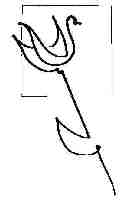
Dr.
Norman Allan's
Newsletter
Vol 1,
No. 9,
December 2005

 |
Dr.
Norman Allan's Vol 1,
No. 9, |
 |
|
* newspaper
clippings ! |
||
|
* * *
|
||
Again, the bulk of this newsletter is made up of items I've seen in the press, related to health, that you might have missed, that I found interesting. It's also an opportunity for me to remind you of my open house on Thurs. from 3 to 6 pm. |
||
|
* * *
|
||
|
Meditators have
more grey matter, study finds. "...Boston
(Yale) researchers found that parts of the brain important for attention
and sensory processing ... were thicker in meditators." Published
in NeuroReport, MRI studies showed that people doing an average
of 40 minutes Buddhist insight meditation, for a number of years had
more grey matter. MRI studies found parts of the
cerebral cortex associated with emotion and internal perception of body
states, where thicker. (The study did not
establish whether the meditation caused the increase or whether people
with more neurons in these areas are predisposed to meditate!) |
||
|---|---|---|
|
* * *
|
||
|
Hormonal Control
of Appetite: Scientists at Stanford,
elaborating on our knowledge of the hormonal control of appetite (in
mice), have found a hormone, manufactured in the stomach and small intestine
which "seems to prompt the brain to send out a message that says
'eat less'." The hormone, obestatin,"seems to reduce hunger
in part by slowing the passage of food through the" gut. |
||
|
* * *
|
||
|
"Even safe
water can carry risks" "Serious kidney damage shown by more than 200 residents
of Walkerton, Ont., is the result of drinking too much water, not E.
coli poisoning ... "8 glasses a day," they say. Recall the article on the dangers of overhydration during strenuous exercise in May 2005's newsletter. Water is "salubrious" in moderation. Don't overdo it. |
||
|
* * *
|
||
|
Panic and Breath There was a recent article in the New York Times Science section on the association of breath and panic attacks. The bottom line is that deep breathing exercises can be very helpful with anxiety and panic. However, I was a little confused by the rationale. The article claimed there was an association between high carbon dioxide levels in the blood an panic and spoke of an association between hyperventilation and panic. I think, very possibly, the authors got this all backwards. In hyperventalation, from shallow rapid breathing, be "gas off" carbon dioxide reducing the carbon dioxide (hence the paperbag over the head story - to increase the carbon dioxide!) and the bicarbonate in the blood. The bicarbonate is an important alkalis of the blood and its reduction leads to respiratory acidosis, and this reduced carbon content, "hypocapria", is what may be associated with anxiety and panic. Either way, breath deeply, and slowly. |
||
|
* * *
|
||
|
Other Headlines: "Research
Suggests Exercise May Keep Senility at Bay" The
"energy drinks", which is the big thing in the beverage industry,
are primarily caffeine deliver systems. The companies claim that the
other things added, ginseng, for instance, take the "jolt"
out of the caffeine hit. |
||
| * * * | ||
| * * * | ||
|
Dr.
Norman Allan Enrollment
is a limited
|
||
|
7:00
to 9:00 at 2 College Street, suite 305
The
workshop will introduce us to many aspects of this wonderful, gentle therapy.
CranioSacral therapy is subtle. You don't have to be a rocket scientist
to learn it, but you need to be sensitive. Cranial work opens us to a
new understanding of the body and gives us a powerful tool to relax and
to heal. Enrollment
is a limited Phone
416 928 9272
|
||
|
* * * |
||
|
Dr. Norman Allan's Newsletter, November: snippets from newspapers, various, which I hope are of interest. Dr. Norman Allan's Newsletter, October: as above. Dr. Norman Allan's Newsletter, August/September: Dr. Norman Allan's Newsletter, June/July 2005: Dr. Norman Allan's Newsletter, May 2005: Dr. Norman Allan's Newsletter, March/April 2005: an essay on immune tonics published in "Healthy Directions" - and snippets from newspapers, various, which I hope are of interest. Dr.
Norman Allan's Newsletter, February 2005: snippets from newspapers,
various, which I hope are of interest - and a discussion of "C Reactive
Protein" as an indicator of risk for heart disease. |
||
|
* * *
|
||
| What's new in my "practice":- | ||
|
visit
Dr. Allan's home page at
www.normanallan.com |
||